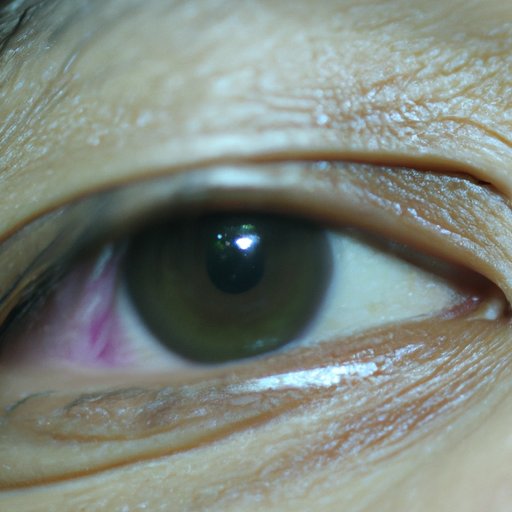
Introduction:
Have you ever experienced red, itchy, and watery eyes? You could be suffering from pink eye, also known as conjunctivitis. Pink eye is a common condition that causes inflammation of the conjunctiva, the thin layer covering the white part of the eye and the inner eyelids. The good news is that it usually resolves on its own in a few days. However, understanding the symptoms, causes, diagnosis, treatment options, and prevention methods can help you make an informed decision and prevent the spread of the infection. In this article, we’ll explore everything you need to know about pink eye.
Symptoms to Look for:
The most common symptoms of pink eye include redness, itchiness, irritation, tearing, and discharge from the eye. The eyelids may also stick together, especially in the morning, making it difficult to open the eye. Additionally, pink eye can cause sensitivity to light and blurred vision. It’s important to note that the symptoms may vary depending on the type of pink eye:
Bacterial pink eye: This type of pink eye typically produces a thick, green or yellow-colored discharge. The eye may also appear very red and swollen.
Viral pink eye: This type of pink eye usually affects both eyes and causes a discharge that’s more clear and watery. You may also experience cold-like symptoms, such as a sore throat, runny nose, or fever.
Allergic pink eye: This type of pink eye is caused by an allergic reaction to substances such as pollen, pet dander, or dust. In addition to the classic pink eye symptoms, you may also experience itchiness and swelling in other parts of the face, such as the nose and throat.
Causes of Pink Eye:
Pink eye can have various triggers, including:
Allergies: Allergic pink eye is caused by an allergic reaction to substances that trigger your immune system, such as pollen, dust, or pet dander.
Infections: Bacterial and viral infections are common causes of pink eye. Bacterial infections are typically caused by the Staphylococcus or Streptococcus bacteria, while viral infections are usually caused by adenoviruses.
Environmental factors: Exposure to smoke, pollution, or certain chemicals can cause irritation in the eyes and lead to pink eye.
Contagion: Pink eye can also be transmitted from person to person through direct or indirect contact with an infected individual’s eye secretions. This makes pink eye highly contagious in settings such as schools, daycares, and nursing homes.
Diagnosis Methods:
To diagnose pink eye, your doctor will perform a physical examination of your eye and ask about your symptoms and medical history. In some cases, they may also collect a sample of the eye discharge to test for the presence of bacteria or viruses.
The diagnosis may differ depending on the type of pink eye:
Bacterial pink eye: Your doctor may prescribe antibiotic eye drops or ointment to treat bacterial pink eye.
Viral pink eye: Unfortunately, there’s no cure for viral pink eye. However, your doctor may prescribe antiviral medication or recommend over-the-counter eye drops to help alleviate the symptoms.
Allergic pink eye: Your doctor may advise you to avoid allergens that cause the allergic reaction, prescribe antihistamine eye drops, or recommend other allergy medications.
Treatment Options:
If you have pink eye, there are several treatment options you can try:
Over-the-counter eye drops: Artificial tears or eye drops can relieve itchiness, dryness, and redness.
Prescription medication: Your doctor may prescribe antibiotic or antiviral drugs to treat severe cases of pink eye.
Home remedies: Applying a warm or cold compress to the affected eye, practicing good hygiene habits, avoiding contact with the eye, and cleaning your contact lenses can help alleviate the symptoms and prevent the spread of pink eye.
When to See a Doctor:
You may not always need to see a doctor for pink eye, especially if you have mild symptoms that don’t persist or worsen after a few days. However, you should seek medical attention if:
– You experience severe pain or sensitivity to light
– You have impaired vision
– Your symptoms don’t improve with home remedies or over-the-counter medication
– You have a weakened immune system, such as due to HIV or chemotherapy
If you do visit a doctor, be sure to inform them of any medication you’re currently taking, as well as any existing allergies or medical conditions.
Preventing Pink Eye:
There are several ways to prevent the spread of pink eye:
Wash your hands frequently: Regularly washing your hands with soap and water can help prevent the spread of bacteria and viruses that cause pink eye. Avoid touching your eyes with unwashed hands.
Avoid sharing personal items: Don’t share towels, makeup, or other personal items that come into contact with the eyes with others, especially if they have pink eye.
Avoid contact with infected individuals: Stay away from people who have pink eye, especially in settings such as schools, daycare centers, and nursing homes.
Maintain good eye hygiene: Clean your contact lenses regularly, avoid rubbing your eyes, and remove eye makeup before going to bed.
Conclusion:
Pink eye is a common and often harmless condition that can be treated with proper care and attention. Being aware of the symptoms, causes, diagnosis methods, and treatment options can help you make informed decisions and prevent the spread of infection. If you experience symptoms of pink eye and they persist or worsen, be sure to seek medical attention promptly.
Additional resources:
- American Academy of Ophthalmology (https://www.aao.org/eye-health/diseases/allergic-conjunctivitis-pink-eye)
- American Optometric Association (https://www.aoa.org/healthy-eyes/eye-and-vision-conditions/pink-eye?sso=y)
- Centers for Disease Control and Prevention (https://www.cdc.gov/conjunctivitis/index.




